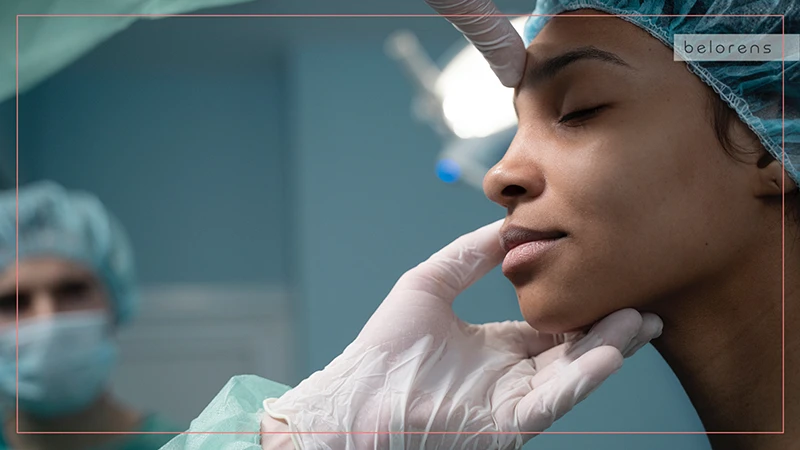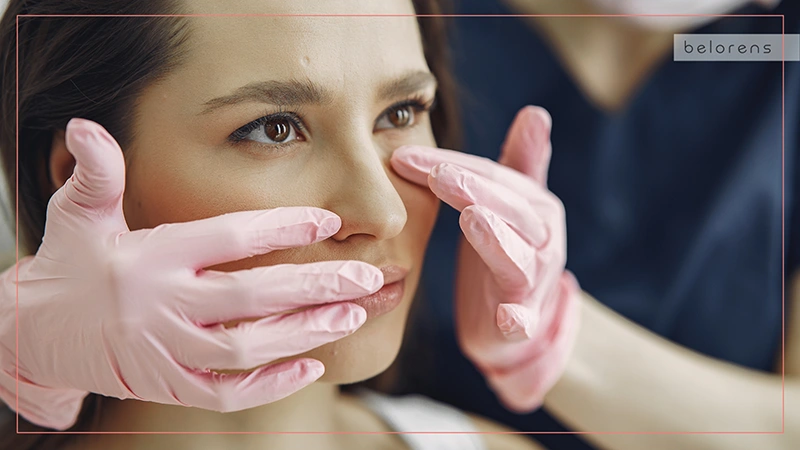Published on 11 Feb 2024
Open vs Closed Rhinoplasty: Everything You Need to Know
- ByMedical Content Team
- Medically Reviewed byDr. Sabine Kulhanek
Fact checked

When it comes to the way surgeons carry out nasal surgery, two primary techniques are widely used: open and closed. The decision between these approaches can feel overwhelming, but understanding their nuances is crucial in making an informed choice that aligns with your goals.
In this blog post, we will explore the contrasting characteristics of open and closed rhinoplasty, providing you with valuable insights into their advantages, limitations, recovery processes, and suitability for different nasal concerns. By unraveling the mysteries behind each method, we aim to empower you with knowledge so that you can confidently embark on your journey toward a beautifully enhanced nose that harmonizes flawlessly with your facial features.
What Is Open and Closed Rhinoplasty?

Open and closed rhinoplasty, also known as external and internal rhinoplasty, are the primary approaches used in nose surgery. Closed rhinoplasty was the initial method employed by many surgeons and is still widely practiced today. It involves making small incisions inside the nostrils without lifting back the skin to make alterations to the nose. However, with advancements in surgical techniques, open nose surgery has become more prevalent recently.
The primary distinction lies in the surgical approach of open and closed rhinoplasty. Open rhinoplasty involves making an incision on the soft tissue between the nostrils (columella) and lifting back the nasal skin, providing better access to address functional or aesthetic issues of the nose.
In contrast, closed rhinoplasty achieves similar goals but with all incisions made inside the nostrils without lifting back the nasal skin.
However, there are additional differences between these two methods that should be considered. Let's explore their respective advantages and disadvantages to help you determine which option is most suitable for your needs:

Advantages of Open Rhinoplasty
- Enhanced visibility: The surgeon has a clear view of the underlying nasal structures, enabling more precise modifications.
- Easier stabilization: After surgery, it is relatively straightforward to secure and support the nose.
- Availability of skilled surgeons: Due to its widespread use, finding experienced practitioners who specialize in open rhinoplasty may be easier.
Disadvantages of Open Rhinoplasty

- Longer recovery time: The more invasiveness of open rhinoplasty typically leads to extended healing periods.
- Potential visible scar: A small scar may be noticeable on the columella when tilting one's head back.
Advantages of Closed Rhinoplasty
- Less invasive procedure: Closed rhinoplasty involves minimal external alteration and often results in reduced swelling/bruising post-surgery.
- No visible external scars: Since all incisions are concealed within the nostrils, there is no noticeable scarring.
- Shorter surgical duration: Compared to open rhinoplasties, closed procedures tend to take less time.
Disadvantages of Closed Rhinoplasty
- Limited visibility for surgeons: The lack of direct visualization can make intricate changes more challenging during surgery.
- Fewer skilled practitioners available: As closed rhinoplasties require specific expertise, locating qualified surgeons proficient in this technique might pose a greater challenge.
- Potential weakening of nasal structure: Closed rhinoplasty involves making internal incisions within the nose to access and reshape nasal structures. In some cases, this technique may lead to weakening of these structures, potentially affecting long-term stability.
When deciding between open and closed rhinoplasty, it is crucial to weigh the advantages and disadvantages of each method against your specific requirements. Consulting with a qualified plastic surgeon will provide personalized guidance based on your unique circumstances.
How is Open Rhinoplasty Performed?
Here's an overview of how open rhinoplasty is typically performed:
- Anesthesia: The procedure begins with the administration of anesthesia, ensuring that you are comfortable and pain-free throughout the surgery. Your surgeon will discuss the appropriate type of anesthesia for your specific case.
- Incision: To access the underlying nasal structures, an incision is made on the soft tissue between your nostrils, known as the columella. This incision allows for better visibility and facilitates modifications to reshape and refine various aspects of your nose.
- Skin elevation: Once the incision is made, your surgeon carefully lifts back or elevates the skin covering your nasal framework and exposes it for further evaluation and adjustment.
- Structural modification: With direct visualization achieved through this open approach, your surgeon can meticulously modify different components such as cartilage, bone, or septum to achieve desired changes in shape, size, symmetry, or overall appearance of your nose.
- Reshaping and refinement: Using specialized instruments and techniques suited to each unique case, adjustments may be made to correct structural irregularities like humps on the bridge of your nose or deviations in shape caused by injury or genetics.
- Closure: Once all necessary modifications are complete according to your desired outcome discussed during preoperative consultations with your surgeon), they will then reposition and secure tissues before closing up using sutures (stitches).
- Post-operative care: After completion of the procedure, nasal dressings or splints may be applied externally along with internal packing if required (depending on individual cases) to support healing processes while maintaining proper alignment during initial recovery stages.
How is Closed Rhinoplasty Performed?
Here's an overview of how internal rhinoplasty is typically performed:
- Anesthesia: The procedure begins with the administration of anesthesia to ensure your comfort and pain management during surgery. Your surgeon will discuss the appropriate type of anesthesia based on your specific case.
- Incisions: In contrast to open rhinoplasty, all incisions in closed rhinoplasty are made inside the nostrils (endonasal). This approach avoids any external visible scarring as there are no incisions made on the columella or other visible areas.
- Accessing nasal structures: Once the internal incisions are made within the nostrils, your surgeon gains access to underlying nasal structures such as cartilage and bone that require modification.
- Structural modification: Using specialized instruments designed for closed techniques, your surgeon can reshape and refine various aspects of your nose through these internal incisions. They can adjust cartilage, reduce or augment certain areas, correct deviations, or improve symmetry depending on your desired outcome discussed during preoperative consultations.
- Suturing and closure: After making necessary modifications to achieve desired results, sutures (stitches) are applied internally within the nostrils to secure tissues in their new positions
- Post-operative care: Following completion of the procedure, closed rhinoplasty may involve placing intranasal splints/stents temporarily to support healing and maintain proper alignment while reducing post-operative swelling. Alongside this, internal absorbable sutures may be utilized which do not require removal at a later stage. External dressings/splints might not be required in all cases but could be employed if deemed necessary by the surgeon based on individual circumstances. Follow-up appointments will be scheduled to monitor healing progress and address any concerns during the recovery period.
Open vs Closed Rhinoplasty Recovery

The recovery process following both open and closed rhinoplasty procedures shares some similarities, but there are also specific differences to consider. Here's an overview of what you can generally expect during the recovery period for each technique:
Open Rhinoplasty Recovery
- Swelling and bruising: external rhinoplasty typically involves more extensive tissue manipulation, which can result in increased swelling and bruising compared to closed rhinoplasty. The majority of the swelling will subside within the first few weeks, but it may take several months for all residual swelling to fully resolve.
- Nasal packing or splints: Depending on your surgeon's preference and individual needs, nasal packing or external splints may be utilized temporarily after open rhinoplasty surgery to support healing and maintain proper alignment. These are usually removed within a week.
- Sutures removal: If non-absorbable sutures were used during the procedure, they will be removed approximately one week after surgery.
- Recovery timeline: Most patients can anticipate returning to work or school within 1-2 weeks post-surgery. However, complete healing and final results may take several months as internal tissues continue to settle.

Closed Rhinoplasty Recovery
- Swelling and bruising: Closed rhinoplasty generally leads to less extensive trauma compared to open techniques, resulting in reduced overall swelling and bruising.
- Nasal packing or splints: Similar to open rhinoplasties, internal nasal packing or intranasal splints might be applied temporarily depending on individual cases.
- Recovery timeline: Patients undergoing closed rhinoplasty often experience a shorter initial recovery period than those who undergo open techniques due to its less invasive nature. Many individuals can return to their normal activities (work/school) within 1 week post-surgery.
It is important to note that these timelines are general estimates, and individual experiences may vary based on factors such as personal health conditions, the complexity of the procedure, and your body's unique healing ability. Your surgeon will provide specific post-operative instructions and closely monitor your progress during follow-up appointments to ensure proper healing.
Is Closed Rhinoplasty Cheaper?

The cost of open or closed rhinoplasty can vary depending on various factors such as the surgeon's experience, location, facility fees, anesthesia costs, and the complexity of the procedure. However, in general, a nose job with the open approach tends to be more expensive than a closed nose surgery.
Open rhinoplasty typically requires additional surgical time due to the need for an external incision and lifting back of nasal skin. It may also involve more extensive tissue manipulation and require specialized techniques for better visibility during surgery. These factors contribute to increased costs associated with open rhinoplasty procedures.
On the other hand, closed nose surgery is generally less invasive as all incisions are made internally within the nostrils. This technique often involves a shorter surgical duration and potentially fewer required resources compared to open techniques. As a result, closed rhinoplasties tend to have lower overall costs compared to open procedures.
However, the situation could differ in specific geographic areas. Although open rhinoplasty operation may have a longer duration than closed rhinoplasty, the latter is considered more intricate and challenging by surgeons and requires a higher level of skill. Also, there are a limited number of surgeons specializing in closed nasal surgery. Consequently, some nasal surgeons may charge a higher fee for performing closed rhinoplasty.
Also Read: How to Choose the Right Rhinoplasty Surgeon?
It is important to note that while cost is a factor worth considering when choosing between these approaches, it should not be the sole determining factor in your decision-making process. Prioritize finding a skilled and experienced plastic surgeon who specializes in your desired technique (open or closed) and has a track record of delivering successful results.
Summary: Should I have Open or Closed Rhinoplasty?
Determining whether to undergo open or closed rhinoplasty depends on several factors. Each technique has its own advantages and disadvantages, making one more suitable than the other based on individual circumstances and desired outcomes.
The surgeon's expertise in each method plays a crucial role in deciding which approach to take. Through thorough pre-operative consultations, all concerns will be addressed, and the most appropriate surgical technique will be determined.
Open rhinoplasty is generally suitable for various nose types as it allows the surgeon unrestricted access during the procedure. It is recommended for individuals seeking significant changes such as altering nose size, removing dorsal humps, or correcting nasal tip issues. Moreover, it is particularly beneficial for those undergoing revision rhinoplasty. It's important to note that many experts believe open rhinoplasty is best suited for challenging anatomical variations of any kind.

On the other hand, closed nose surgey is ideal for individuals desiring minor changes primarily focused on the nasal bridge. This technique offers faster recovery with minimal downtime, especially for cases with straightforward nasal anatomy.
Ultimately, trust in the expertise of your chosen surgeon who can provide personalized recommendations based on their evaluation of your unique situation and aesthetic goals. They will guide you toward selecting the approach that best aligns with achieving optimal results while considering factors such as anatomical considerations, complexity of procedure required, expected outcomes, risks involved, and personal preferences.




